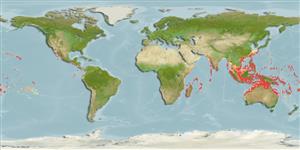Common names from other countries
Environment: milieu / climate zone / depth range / distribution range
Ecología
marino asociado a arrecife; no migratorio; rango de profundidad 5 - 135 m (Ref. 90102), usually 5 - 20 m (Ref. 58302). Tropical; 30°N - 30°S
Indo-Pacific: East Africa to the Galapagos Islands, north to Ryukyu and Hawaiian islands, south to Australia and the Tuamoto Islands.
Tamaño / Peso / Age
Maturity: Lm ? range ? - ? cm
Max length : 10.0 cm TL macho / no sexado; (Ref. 4313)
Espinas dorsales (total) : 12; Radios blandos dorsales (total) : 8 - 11; Espinas anales: 3; Radios blandos anales: 5 - 6. Tan to reddish or brown in color (Ref. 4313). Has prickly papillae instead of scales. Dorsal fin high, 3rd or 4th spine longest; suborbital ridge without spines or with lump at head of ridge; preopercle with 2 indistinct spines only; body extremely compressed; soft dorsal fin attached to the caudal fin; coloration is variable, from nearly all yellow to red, brown or nearly black and variously mottled with darker pigment (Ref. 10482).
Inhabits reef flats, outer reef slopes, current-swept channels, and rarely on lagoon reefs (Ref. 1602). Benthic (Ref. 58302). Solitary and usually immobile among algae or seagrass but effects hip movements resembling that of a leaf falling down from a tree. Molts twice a month with the skin breaking off first in the head region. Has the habit of mimicking a dead leaf by swaying from side to side (Ref. 37816). Feeds on small crustaceans and fishes (Ref. 9710); also feeds on larvae (Ref. 5503). Venomous spines.
Life cycle and mating behavior
Maturities | Reproducción | Spawnings | Egg(s) | Fecundities | Larva
Myers, R.F., 1991. Micronesian reef fishes. Second Ed. Coral Graphics, Barrigada, Guam. 298 p. (Ref. 1602)
IUCN Red List Status (Ref. 130435)
CITES (Ref. 128078)
Not Evaluated
Human uses
Pesquerías: comercial; Acuario: Comercial
Herramientas
Special reports
Download XML
Fuentes de Internet
Estimates based on models
Preferred temperature (Ref.
115969): 24.6 - 28.8, mean 27.5 (based on 566 cells).
Phylogenetic diversity index (Ref.
82804): PD
50 = 1.0000 [Uniqueness, from 0.5 = low to 2.0 = high].
Bayesian length-weight: a=0.01259 (0.00606 - 0.02615), b=3.03 (2.86 - 3.20), in cm Total Length, based on LWR estimates for this (Sub)family-body shape (Ref.
93245).
Nivel trófico (Ref.
69278): 4.1 ±0.68 se; based on food items.
Resiliencia (Ref.
120179): Alto, población duplicada en un tiempo mínimo inferior a 15 meses (Preliminary K or Fecundity.).
Fishing Vulnerability (Ref.
59153): Low vulnerability (10 of 100).
